8 Insane Things From the Never-Made Oliver Stone/Arnold Schwarzenegger Planet of the Apes
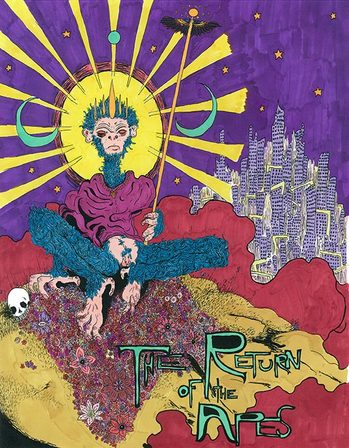 |
In 1994, as Oliver Stone’s Natural Born Killers was being released, his producers Don Murphy and Jane Hamsher were looking for the trio’s next project. (Hamsher recounts these events in her book, Killer Instinct). Murphy was a lifelong fan of the Planet of the Apes series, and sort of haphazardly threw Stone into a meeting with a roomful of studio executives. As they were eagerly leaning in to see Stone reveal his master plan for Apes, he said, “Oh, I don’t know, I watched the original films a couple nights ago and they are awful. I’m only here because of Don Murphy. You should talk to him.” A roomful of betrayed executives glared at Murphy. Murphy started floundering and pitching the potential for Happy Meal toys, and was met with embarrassment and dismay. Finally, Stone stepped in and delivered an idea that Hamsher jokes was an acid flashback. “What if time were not linear, but circular, and there was no difference between the past and the future?…And what if there were discovered cryogenically frozen Vedic Apes who held the secret numeric codes to the Bible that foretold the end of civilization?” The execs loved it and cut Stone a check.
Thus begins the tale of the production of Return of the Apes. Jane Hamsher worked with Road Warrior/Beyond Thunderdome screenwriter Terry Hayes, and they were able to produce a screenplay that attracted Arnold Schwarzenegger to star in the leading role. Some bizarre pieces were falling into place, so we tracked down a copy of the script to see just how they would have landed.
1. Characters Named After Lord of the Rings and Other Strange Pop-Culture References
 |
This isn’t a coincidence. It’s not like two people named John Smith or something. Hayes has leading apes named Strider and Nazgul, as well as a human named Aragorn. Aragorn is a slave to the apes, but among humans he was a leader figure, just like Tolkien’s Aragorn. He also possesses a piece of silver, which he swears is called ‘mithral.’ [sic]
But it doesn’t stop at Lord of the Rings. Arnold’s character has two names. In his secret past life, he was a scientist named Robert Plant. Possibly tired of getting phone calls from countless Led Zeppelin fans, he changed it to…Will Robinson. Our lead female, Billie Rae Diamond, figures this out, and even laments, “You really were ‘Lost in Space’ weren’t you?” This is after Will has said that the swarms of apes are ‘just like Storm Troopers.’ We also get two Biblical references, with a high priest named Ma-Gog and a little girl named Eve. And finally, there is an ape whose name is a reference to Zira from the original Planet of the Apes series, except here she is named Zora.
Towards the beginning of the story, Will finds a tape of himself giving a speech, presumably as Dr. Robert Plant. The only clip we hear is, “I have had the opportunity to work with three talented colleagues. I’m also privileged to call them my friends.” And then he shuts off the tape, a look of pain on his face. As Apes fans, are we to deduce that he was friends with the three astronauts from the first film? It’s a stretch, but that’s nothing compared to the plot.
2. The Virus/DNA Time Traveling
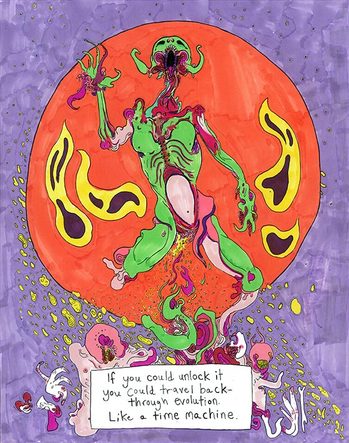 |
From Page 12: “‘I can’t recall the details but someone had the idea that mitochondrial DNA was like a genetic memory. If you could unlock it, you could physically travel back down it. Through evolution – like a time machine.’ “
The main story, whittled down from Stone’s circular time theory, is this: Will and Diamond go back in time to stop a mutation that was invented by the apes and planted in our genetics like a time bomb. And he does this using DNA and a CD-ROM. Early in the script, Will befriends an apathetic UC Berkeley janitor – “They treat me like shit. Worse than shit. All work, no appreciation” – who helps him gain access to the basement, where some flotation tanks are held. These tubes happen to be ideal for time travel. Awesome.
So what’s this mutation? Well, it’s gruesome, but it’s a compelling concept. The human life cycle accelerates exponentially, like some sort of hyper-progeria, so that we die of old age before even leaving the womb. After multiple cases of babies being stillborn fully aged, Will realizes it’s time to dust off his crackpot theory and put it to the test; he was the “someone” in the quote above – but as Robert Plant, not Will Robinson. Whatever the case, the old baby plot device is used with strength and clarity, and it serves the story well. It also makes for an insane intro. The first three pages are a delivery and autopsy scene as intense as any action sequence to follow.
3. A Steampunk War Tank Trinity: The Claw, The Balls, The Flame
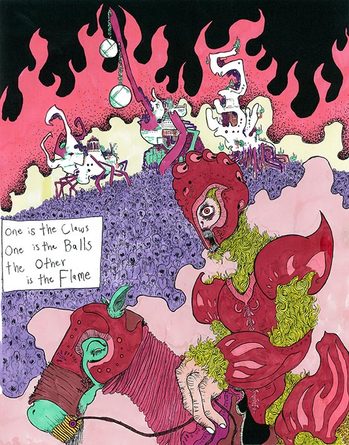 |
Page 30: “Rage flashes in Will’s eyes… Ape infantry – foot soldiers – are coming into the gorge behind him. In their midst are three huge steam driven machines – like iron Erector Sets. One is The Claw, one is The Balls and the other is The Flame.”
Not long after Will gets to Ape City, he finds himself in some trouble. He is a civilized human, after all, and immediately lands on the wrong side of ape society. During an escape scene we see the technology of the ape military, and it is deliciously steampunk. The first machine the audience gets a good look at is The Balls. It’s as simple and ridiculous as it sounds: two giant wrecking balls hang from an ‘overhead jib,’ where the ape sits. The Balls are used to break down a massive wooden door, making way for The Claw: iron jaws that can snap the door’s giant crossbeam like a twig. Commotion ensues, and Will is captured before we see much of The Flame. But don’t worry: Will pilots it himself in the final battle!
The idea of Arnold controlling a giant steampunk flame-thrower tank is classic enough, but when it runs out of flamethrower fuel, he accelerates and charges down a hill like a battering ram. As it gains speed, an ape general named Drak races alongside on horseback, trying to find Will, who has exited the cockpit and is hanging off the other side. It crashes into the village below, causing quite the upset. Meanwhile, we’re left poring through the pages of the script, Erector Sets in hand, looking for just one more clue on how to build those awesome machines.
4. The Vet/ Blood Transfusion
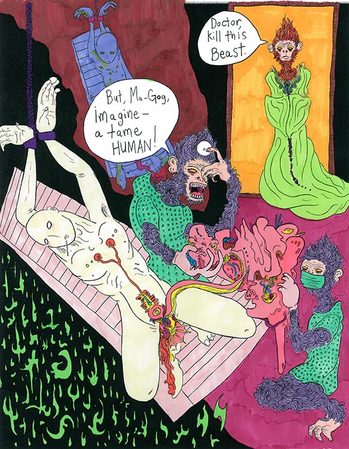 |
Page 38: “An ape in a leather apron uses a grinding wheel to sharpen a gruesome looking knife. This is the VET. Will lies on a stone slab nearby – it’s a sort of medical center: sinks along the walls, racks of equipment, hoses to wash down the blood.”
I mentioned above that after we first see the Balls and Claw, Will is captured. This isn’t an easy task for Drak and his apes, and they end up almost killing him. Will is taken back to the heart of Ape City, and he’s actually bleeding to death when Zora demands for Drak to call a Vet. Knowing this human stranger needs to be studied, Drak agrees. “I didn’t bring him all this way just to have him die.” This is also when we meet Aragorn, a human slave who is forced to be a donor in an ape-performed blood transfusion.
The Vet promptly produces an animal intestine, complete with digestive tubing on each end. He attaches needles to both tubes, heats them until red hot, and inserts one into Aragorn and the other into Will. Blood flows under the fleshy tissue and fills the bladder with blood before it drains into Will. When asked if it will work, the Vet replies, “You can never tell with these animals. Their bodies aren’t as sophisticated as an ape’s. Sometimes their blood fights with each other. Either way, you know really quick – they get up and walk around, or they’re dead.” Ma-Gog (the priest) barges in on the surgery, wearing a lion skin. After one look at Will, he’s convinced this sophisticated human creature is the fulfillment of an evil prophecy and halts the process by throwing the bladder on the ground. He’s too late though, and Will wakes up. What can we learn from this? For one, ape medical school is a lot like ours: it takes a lot of guts.
5. The Young Ape’s Manhood Ceremony
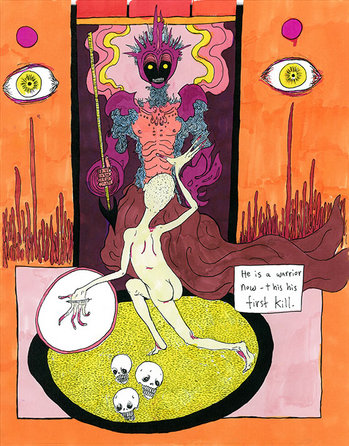 |
Page 113: “A young ape, barely in his teens, stands in the middle of the room, almost naked. His face is painted with strange ochre markings. A circle of ape warriors watch as Ma-Gog lifts a slender blade…and slices the Teenager’s forehead. The Teenager winces but doesn’t cry out – this is his manhood ceremony.”
This one is pretty straight forward, as this ceremony was only a catalyst for our human characters to do some sneaking. It does get pretty intense, though, as you can imagine after some of the stuff we’ve already seen. A 12-year old human boy is separated from his mother and forced into the ring to be the Ape Teenager’s first kill. The crowd, relentless as ever, chants “Kill! Kill! Kill!” Just in time, the alarm sounds, sending the crowd into a frenzy and saving the human boy. He sees his opportunity and raises his spear, driving it “deep into the ape’s groin.” The ape slumps dead and traps the boy beneath his dead body. Later, the boy’s mother finds him, and even though his rib cage has been slashed open, he’s ok.
Part of what enticed Arnold about this script was his desire for a “bloody, violent, gory ape movie.” Hamsher recalls meeting with him in his Conan-ified lair and hearing his enthusiasm for the project. However, the script was already written before Arnold was attached, so this was not a case of writing to accommodate star power. Which may be hard to believe during this next scene…
6. “Dirty Ape” Drak Meets His Demise
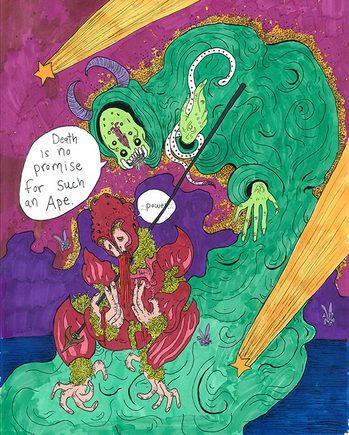 |
Page 124: “Drak aims the harpoon. He’s got Eve and Diamond, one behind the other, in his sights. On The Claw, Will spins a small steering wheel….”
Drak is pretty ruthless, and shoots Aragorn though the chest with a harpoon. Eve and Diamond, who serve as this film’s Newt and Ripley, are next on his list, but Will has other plans. Drak aims. Will, in the Claw, comes chasing after him, the iron jaws wide open. Drak screams and runs. Will flips a lever, and then… “Keep your hands off her, you dirty ape.”
Arnold delivering a variation of Charlton Heston’s classic line. Since this film’s style is so radically different from the source material, it’s hard to say if this moment would have been a triumph for Apes fans, or more of a slap in the face. But after that setup, it seems perfect for Arnold, and certainly had all the makings of a crowd pleaser.
So Will says the line and scoops up Drak with The Claw. Clumsy with the controls, he flips levers as Drak fires the harpoon gun. As Will finds the ‘squeeze’ lever, he stares Drak in the eye, watching until his hand goes limp. Holding Drak high above the other apes, they watch in horror as he is cut in half and everything from the waist down falls to the ground. The humans attack and the apes retreat.
7. Statue of Liberty
 |
Page 127: “The surf rolls in on a golden beach. At the water’s edge, a line of footprints. We follow them to find Will on top of a rocky cliff. He’s building something out of iron and rock and sand but we can’t make out what it is.
So Will and Diamond do indeed defeat the virus after tracking down the group of test subjects the apes were using for experiments. We also discover that they are stuck in the past, and will not be able to return to where they came from. So what do you do when you can’t get back home to modern civilization? After you’ve saved man but are doomed to live with the apes?
You build a Statue of Liberty out of rock and sand and iron. Will says proudly as the film closes, “It’s to make sure we never forget where we came from.” Would this have been another facepalm moment for most Apes fans? Essentially Will has built a Statue of Liberty steampunk sandcastle, forcing the classic Apes imagery into this modern aesthetic. Reading that line in Arnold’s voice, imagining how ludicrous that situation is, induces a grin and chuckle. But after such a huge production, and with that statement at the end, grins and chuckles aren’t exactly the desired effect. This ending, along with some tonal issues, make it a tricky sell for Apes fans, but given Stone’s opinion of the series it’s safe to say they weren’t really a target demographic.
8. Baseball
So in what realm of film development hell does this gem reside? What exactly went wrong? Jane Hamsher says in Killer Instinct that co-producer Don Murphy got into the film business because of Planet of the Apes. How could he have let this project die? For all the dramatic departures in style to the original series, the script reads well and is the product of a unified (albeit wacky as hell) vision. The answer to these questions is simple: Executive producer Chris Meledandri was promoted to Fox Family, and left the Apes project to a new Executive Producer, Dylan Sellers. Sellers had a vision that rivals Stone’s in ridiculousness, although in Stone’s defense he wasn’t a fan and was starting from scratch. Sellers comes in, reads the script, and knows EXACTLY what the film needs: Baseball. Played by the apes, but coached by Arnold. “What if our main guy finds himself in Ape land, and the Apes are trying to play a game like baseball, but they’re missing one element, like the pitcher or something. And when our guy comes along, he knows what they’re missing, and he shows them, and they all start playing. Kind of like the Flintstones.”
 |
Sellers convinced himself this idea was necessary, and when the script didn’t reflect that, Terry Hayes was fired. Just like that. A new writer was never found, and the whole thing fizzled out. Arnold’s attachment loosened, and Stone sure wasn’t sticking his neck out for the project. After all, he had already been paid for his initial idea, and it was easy for him to step out of the director role.
Jane Hamsher and Don Murphy went on to produce the Double Dragon film among numerous others, and were able to work with Hayes again when they brought him on to adapt Alan Moore’s graphic novel From Hell. After the rollercoaster of a script and the behind-the-scenes politics, Return of the Apes was shelved. A few years later, Sam Hamm would use it as a starting point for a new script, keeping the rapid-aging virus. Versions were passed around, writers left and came, but by the time Tim Burton’s remake came out, any evidence of Return of the Apes had disappeared. Burton’s Apes wasn’t exactly a fan-pleaser, and this 1994 screenplay may not have been either. One thing is clear, though: the film wouldn’t have been boring, and probably would have fit right in with Arnold’s other classics from the era.
A non-formatted, typo-filled version of the script can be read online, but it is a different version than I read. Diamond’s line about Lost in Space is removed, as well as some other differences. Oddly enough, it says ‘first draft’ and is dated 1996, whereas mine was 1994 and also says ‘first draft’. Hamm was working on his version of Apes in 1996, so if anybody has info on that feel free to share. I’d like to thank Scott Bradley for supplying a legitimate hard copy, as well as lending me Killer Instinct.
The amazing concept art was by Matthew Steele.
Also by Bryce Abood:
6 Ways Donkey Konga Out-Rocks Guitar Hero (and 2 Brown Bananas)
